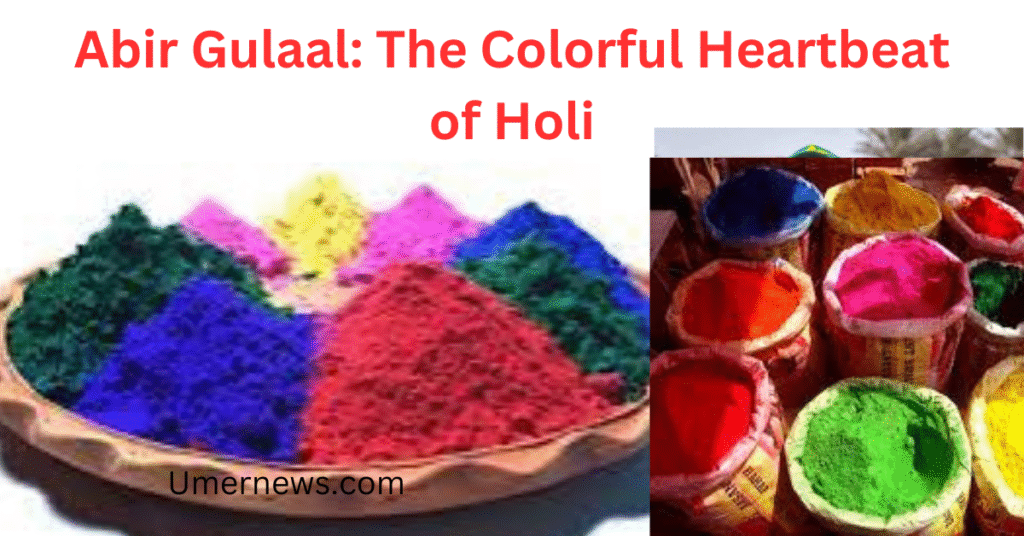Abir Gulaal
Contents
Abir Gulaal: The Colorful Heartbeat of Holi

The vibrant festival of Holi is a kaleidoscope of colors, joy, and togetherness. At the center of this playful celebration lies a powdery magic: abir gulaal. But what exactly is this colorful powder, and why does it hold such a special place in our hearts and traditions? This article will dive deep into the fascinating world of abir gulaal, exploring its history, different types, and the pure joy it brings to millions.
The Origins of Abir Gulaal: More Than Just Color
The tradition of using colored powders during Holi is steeped in mythology and history. While the name “gulaal” simply means a colored powder, “abir” refers to a specific type of fragrant, traditionally white powder made from materials like sandalwood, jasmine, and other natural ingredients. Historically, these powders were made from dried flowers, spices, and herbs, making them completely natural and safe for the skin. Over time, the use of vibrant, artificial colors became more common, but the spirit of playful, colorful exchange remains the same.
Key takeaway: The roots of abir and gulaal are intertwined, with abir representing a traditional, fragrant powder and gulaal being the broader term for all colored powders.
Choosing the Right Gulaal for Your Celebration
With so many options available today, how do you choose the right abir gulaal? It’s crucial to be mindful of the ingredients to ensure a safe and enjoyable experience for everyone.
| Gulaal Type | Features | Pros | Cons |
| Herbal Gulaal | Made from natural ingredients like flowers and vegetables. | Non-toxic, eco-friendly, skin-safe. | Can be more expensive, colors may be less vibrant. |
| Organic Gulaal | Made from certified organic ingredients. | Hypoallergenic, biodegradable, safe for kids. | Premium pricing, sometimes harder to find. |
| Synthetic Gulaal | Made with chemical dyes and synthetic components. | Bright, long-lasting colors, very affordable. | Can cause skin irritation, potential health risks, harder to wash off. |
For a truly authentic and safe Holi, opting for herbal or organic gulaal is highly recommended. Not only are they better for your skin, but they are also a nod to the traditional, natural origins of this beautiful festival. For more information on the history and cultural significance, you can read this detailed article on Wikipedia.
Tips for a Safe and Joyful Holi
Playing with abir gulaal is all about fun, but a little preparation goes a long way in ensuring a safe celebration.
- Protect Your Skin: Apply a thick layer of oil or moisturizer to your skin before you start playing. This creates a barrier, making it easier to wash the colors off later.
- Wear Old Clothes: Opt for clothes you don’t mind getting stained. White clothes are a popular choice to showcase the vibrant colors.
- Guard Your Eyes: Wear sunglasses to protect your eyes from the powder. If you get powder in your eyes, rinse them immediately with clean water.
- Hair Care is Key: Oil your hair generously to prevent the color from clinging to your scalp and strands.
Frequently Asked Questions About Abir Gulaal
Q: What is the main difference between Abir and Gulaal?
A: While often used interchangeably, “gulaal” is a general term for colored powder. “Abir” traditionally refers to a fragrant, often white or lightly colored powder made from natural ingredients like sandalwood, used in religious ceremonies and rituals. Over time, the name has been associated with all Holi powders.
Q: Is Abir Gulaal safe for children?
A: Yes, if you use herbal or organic versions. These are made from natural, non-toxic ingredients and are much safer for a child’s sensitive skin. Always supervise children during playtime to ensure they don’t ingest the powders.
Q: How do you make Abir Gulaal at home?
A: You can make safe, homemade gulaal using kitchen ingredients. For example, use turmeric for yellow, beetroot powder for pink, and henna powder for green. Mix these with a base of cornstarch or rice flour to get the desired texture.
Q: Why is white Abir used in some rituals?
A: White abir, often made from sandalwood, holds a significant place in religious ceremonies. Its pure white color symbolizes peace and purity, and its natural fragrance is considered sacred.
Q: How can I remove Gulaal color from my skin and hair?
A: Don’t scrub vigorously. Start by dusting off the dry powder. Then, use a mild cleanser or a paste of gram flour and yogurt to gently wash the color away. Oiling your hair beforehand will make it much easier to wash out.
Conclusion: The Unifying Power of Abir Gulaal
The tradition of playing with abir gulaal is more than just throwing colors. It’s an expression of freedom, a way to bridge social divides, and a celebration of the human spirit. From the aromatic traditional abir to the vibrant modern gulaal, this colorful powder embodies the essence of Holi—a festival that reminds us to let go of our worries and embrace the joy of being together. So, the next time you get a handful of this magical powder, remember the rich history and beautiful tradition you’re a part of.
What’s your favorite memory of playing Holi with abir gulaal? Share your stories in the comments below!








